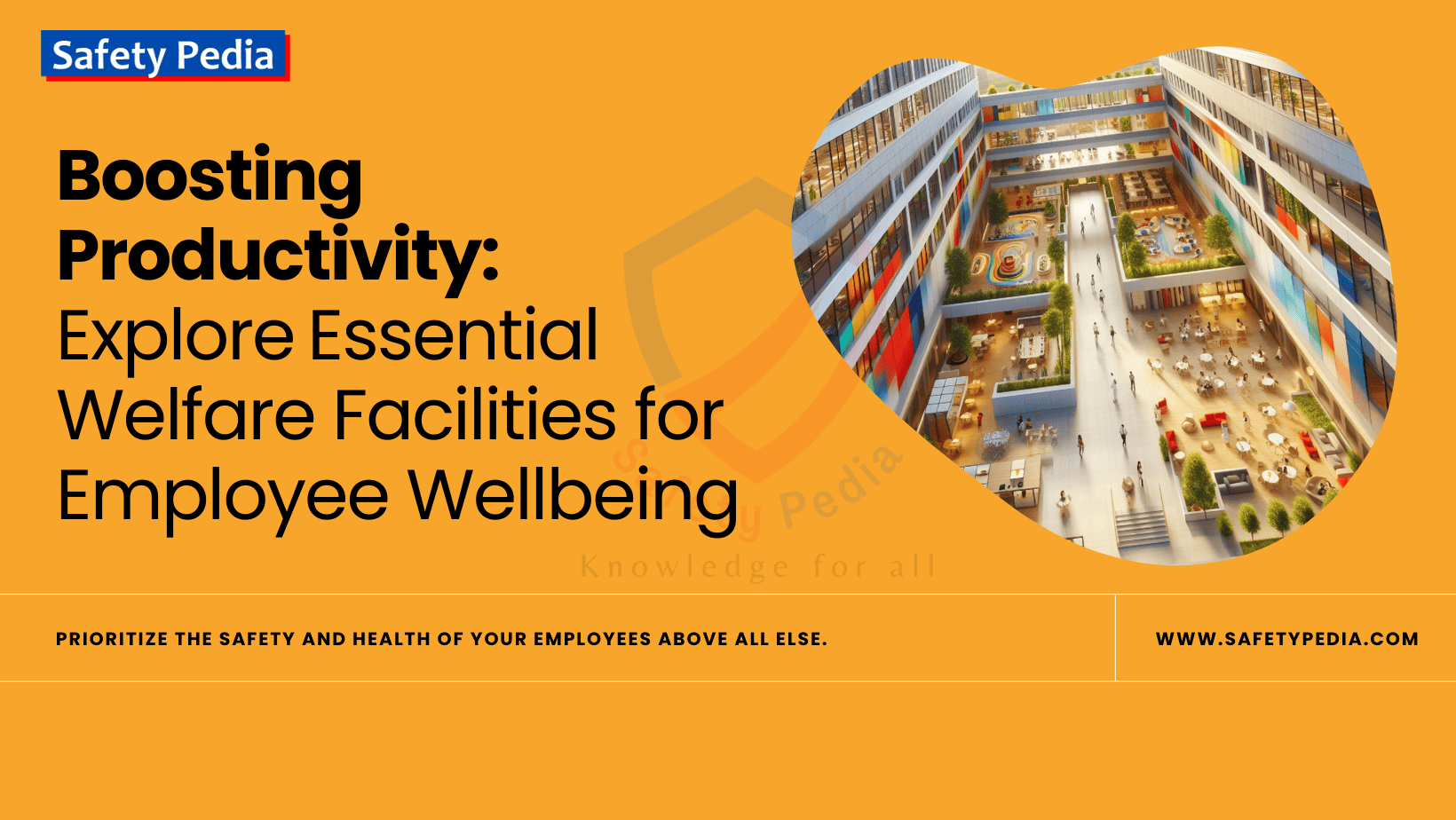
Importance of Welfare Facilities in the Workplace
In today’s fast-paced world, the importance of welfare facilities in the workplace cannot be underestimated. Employees spend a significant portion of their lives at work, and ensuring their well-being is not only ethical but also a smart business move. Companies that prioritize their employees’ welfare see increased productivity, reduced absenteeism, and improved employee satisfaction. Whether it’s comfortable and ergonomic workstations, clean and hygienic restrooms, or access to healthy food options, providing welfare facilities shows that a company values its employees and their needs.
Incorporating welfare facilities into the workplace promotes a positive work culture and facilitates a sense of belonging among employees. According to a survey by Gallup, organizations that have a strong work culture have lower turnover rates and higher levels of engagement. Moreover, welfare facilities also contribute to the physical and mental health of employees, leading to fewer work-related injuries and illnesses, as well as reduced stress levels.
In conclusion, welfare facilities are essential for creating a safe, healthy, and supportive work environment. By prioritizing the well-being of employees, companies can enjoy the benefits of increased productivity, employee retention, and overall business success.
The Impact of Welfare Facilities on Employee Well-being
Welfare facilities play a crucial role in ensuring the well-being of employees. When employees feel valued and cared for, they are more likely to be motivated and engaged in their work. This, in turn, leads to increased productivity and better overall performance. Additionally, welfare facilities contribute to the physical and mental health of employees, reducing the risk of work-related injuries and illnesses. By investing in welfare facilities, companies create a positive work environment that supports employee well-being and promotes a healthy work-life balance.
Furthermore, welfare facilities can also have a positive impact on employee morale and job satisfaction. When employees have access to clean and comfortable facilities, such as restrooms and break areas, they feel more respected and appreciated. This promotes a sense of belonging and loyalty towards the company, resulting in increased employee retention. Moreover, welfare facilities that cater to the diverse needs of employees, such as nursing rooms for new mothers or prayer rooms for religious observances, help create an inclusive and supportive work environment.
In summary, welfare facilities have a significant impact on employee well-being, job satisfaction, and overall performance. By providing these facilities, companies can create a positive work culture and attract and retain top talent.
Legal Requirements for Welfare Facilities in the Workplace
Employers have a legal obligation to provide certain welfare facilities in the workplace. These requirements vary depending on the country and industry but generally include basic amenities such as restrooms, hand-washing facilities, and drinking water. In some jurisdictions, employers may also be required to provide facilities for dining, resting, and changing clothes. Failure to meet these legal requirements can result in penalties and legal consequences for the company.
It is important for employers to familiarize themselves with the specific legal requirements in their jurisdiction and ensure compliance. This may involve conducting regular inspections and audits to identify any deficiencies and take corrective measures. By meeting and exceeding legal requirements, companies demonstrate their commitment to employee well-being and create a positive image as a responsible employers.
Types of Welfare Facilities and Their Benefits
Welfare facilities encompass a wide range of amenities and services that contribute to employee well-being. Some of the most common types of welfare facilities include:
- Comfortable and Ergonomic Workstations: Providing employees with ergonomic furniture and equipment can significantly improve their comfort and reduce the risk of musculoskeletal disorders. Ergonomic workstations are designed to support proper posture and minimize strain on the body, resulting in increased productivity and reduced absenteeism.
- Clean and Hygienic Restrooms: Access to clean and well-maintained restrooms is essential for employee comfort and hygiene. Proper sanitation facilities promote good health and prevent the spread of diseases. Regular cleaning and maintenance of restrooms should be prioritized to ensure a pleasant and hygienic environment for employees.
- Healthy Food Options: Offering healthy food options in cafeterias or through vending machines promotes employee well-being and encourages healthy eating habits. Providing nutritious meals and snacks can boost energy levels, improve concentration, and contribute to overall employee health.
- Fitness and Recreation Facilities: Companies that provide fitness and recreation facilities, such as gyms, sports facilities, or wellness programs, encourage employees to prioritize their physical and mental health. Regular exercise and recreational activities can reduce stress, improve mood, and increase overall well-being.
- Mental Health Support: Recognizing the importance of mental health, some companies offer counseling services or employee assistance programs to support their employees’ emotional well-being. These resources can help employees manage stress, cope with personal challenges, and maintain a healthy work-life balance.
Investing in these welfare facilities has several benefits:
- Employee Satisfaction: Satisfied employees are more likely to stay with the company and be productive.
- Health and Safety: Proper facilities reduce the risk of injuries and health issues.
- Reducing Stress and Burnout: Recreation rooms or relaxing areas help employees recharge during breaks.
- Employee Engagement: Social spaces promote teamwork and collaboration.
- Attracting and Retaining Talent: Competitive welfare facilities make an organization appealing to potential employees.
- Reduced Absenteeism: Access to proper facilities reduces illness-related absenteeism.
By offering these welfare facilities, companies create a supportive and inclusive work environment that promotes employee well-being and enhances overall job satisfaction.
List of Welfare Facilities:
Here’s a comprehensive list of welfare facilities that every workplace should provide for employees. These facilities are essential for ensuring their health, safety, and well-being:
- Sanitary facilities: Clean, well-maintained toilets, handwashing stations with soap and towels, and access to appropriate disposal facilities for sanitary products.
- Clean Drinking water: Readily available clean, fresh drinking water dispensers or bottled water.
- Rest areas: Designated comfortable spaces for breaks, with seating and tables accessible during breaks and non-working hours.
- First aid supplies: Easily accessible basic first-aid supplies and trained personnel or clear procedures for medical emergencies.
- Changing facilities: Secure lockers or designated storage for personal belongings where necessary (depending on work attire).
- Changing Rooms: Secure and hygienic facilities for changing clothes, especially in workplaces with uniforms or protective gear.
- Comfortable workspace: Ergonomic furniture, adequate lighting, temperature control, and noise reduction measures.
- Rest Areas: Employees need a designated space where they can rest during breaks. Comfortable seating and a quiet environment contribute to overall well-being.
- Separate Eating Areas: Having a separate area for eating meals helps maintain hygiene and provides a pleasant space for employees to relax during lunch or snack breaks.
- Provision of Lockers: Lockers allow employees to securely store personal belongings while at work. This helps keep the workplace organized and minimizes clutter.
- Provision of Showers: In certain industries (such as construction or manufacturing), providing showers can be beneficial for workers who get dirty or sweaty during their shifts.
- Relaxation and rejuvenation spaces: Quiet rooms, meditation areas, or outdoor spaces for breaks and stress relief.
- Healthy food options: Subsidized or affordable healthy food choices and snacks, vending machines with healthy options, or access to fresh food markets.
- Hydration stations: Filtered water dispensers, fruit-infused water stations, or easy access to refillable water bottles.
- Fitness facilities: On-site gyms, fitness classes, or partnerships with nearby gyms at discounted rates.
- Health and wellness services: On-site or virtual consultations with health professionals, mental health support programs, or educational workshops.
- Childcare Assistance: Childcare facilities, lactation rooms, flexible work arrangements for parents, or childcare subsidies.
- Eldercare Support: Information and resources for employees caring for elderly dependents.
- Financial wellness programs: Financial planning workshops, access to financial advisors, or employee discount programs.
- Transportation options: Secure bike parking, discounted public transportation passes, or carpooling initiatives.
- Social and recreational activities: On-site events, game rooms, employee lounges, or team-building activities.
- Educational and development opportunities: Tuition reimbursement programs, professional development workshops, or language classes.
- Employee assistance programs (EAPs): Confidential counseling and support services for personal and professional concerns.
- Flexible Working Arrangements: Remote work options, flexible hours, and compressed workweeks.
- Laundry Facilities: On-site laundry facilities or partnerships with dry cleaning services.
- Financial Wellness Programs: Financial education workshops, debt counseling, and retirement savings plans.
- Common Areas: Comfortable spaces for socializing, collaborating, and building relationships.
- Volunteering Opportunities: Partnering with local charities and organizations for employee engagement.
- Accessibility: Ensure all facilities are accessible to employees with disabilities.
- Cultural sensitivity: Tailor facilities and programs to cater to the diverse needs and backgrounds of your workforce.
- Sustainability: Implement eco-friendly practices in water use, energy consumption, and waste management.
- Regular maintenance and upkeep: Ensure all facilities are clean, safe, and in good working order.
- Employee feedback: Regularly solicit employee feedback to identify areas for improvement and prioritize needs.
Remember, providing these facilities isn’t just a legal requirement; it’s essential for creating a positive work environment that supports employee well-being.
How to Create a Comprehensive Welfare Facility Plan
Creating a comprehensive welfare facility plan requires careful consideration of the specific needs and preferences of employees. Here are some steps to follow:
- Assess Employee Needs: Conduct surveys or focus groups to gather employee feedback regarding their welfare facility needs and preferences. This information will help identify the most important areas to focus on and prioritize.
- Research Best Practices: Look into industry best practices and benchmark against other companies known for their excellent welfare facilities. Learn from their successes and adapt their strategies to fit your organization’s unique requirements.
- Develop a Budget: Determine the resources available and allocate a budget for implementing welfare facilities. Consider both the initial costs and ongoing maintenance expenses.
- Prioritize Key Facilities: Based on employee feedback and budget considerations, identify the key welfare facilities that will have the greatest impact on employee well-being. Focus on areas such as restrooms, sanitary facilities, workstations, and break areas, which are essential for employee comfort and productivity.
- Collaborate with Experts: Engage with architects, interior designers, and other professionals who specialize in creating employee-friendly work environments. Their expertise can help optimize the design and layout of welfare facilities.
- Communicate and Educate: Inform employees about the new welfare facilities and how they can benefit from them. Provide training and educational materials on proper facility usage and maintenance.
- Evaluate and Improve: Regularly assess the effectiveness of the welfare facility plan through employee feedback, surveys, and performance indicators. Make necessary adjustments to continuously improve the facilities and address any emerging needs.
By following these steps, companies can develop a comprehensive welfare facility plan that meets the needs of employees and contributes to a positive work environment.
Cost-effective Solutions for Implementing Welfare Facilities
Implementing welfare facilities does not have to be prohibitively expensive. Here are some cost-effective solutions:
- Prioritize Essential Facilities: Focus on providing the most essential welfare facilities first, such as clean restrooms and ergonomic workstations. These are the basic amenities that employees rely on daily and should be prioritized over more extravagant options.
- Consider Shared Spaces: Instead of providing individual facilities for each employee, consider shared spaces that can accommodate multiple employees. For example, creating a common break area with comfortable seating and kitchen facilities can be more cost-effective than providing individual break rooms.
- Negotiate with Vendors: When sourcing furniture, equipment, or services for welfare facilities, negotiate with vendors to secure the best possible prices. Bulk purchasing or long-term contracts can often result in cost savings.
- Leverage Technology: Explore technological solutions that can enhance welfare facilities without significant financial investment. For example, implementing automated hand sanitizer dispensers or touchless fixtures in restrooms can improve hygiene while minimizing ongoing costs.
- Invest in Preventive Maintenance: Regular maintenance and timely repairs can prevent costly breakdowns and extend the lifespan of welfare facilities. Implementing a preventive maintenance schedule can help identify and address minor issues before they become major problems.
By adopting these cost-effective solutions, companies can provide welfare facilities that meet employee needs while managing budgetary constraints.
Case Studies on Successful Implementation of Welfare Facilities
Several companies have successfully implemented welfare facilities and reaped the benefits. Here are a few examples:
- Google: Known for its employee-friendly work environment, Google provides a wide range of welfare facilities, including on-site gyms, swimming pools, massage rooms, and healthy food options. These facilities contribute to employee well-being, job satisfaction, and overall productivity.
- Patagonia: The outdoor clothing company, Patagonia, offers a flexible work schedule that allows employees to engage in outdoor activities. They also provide on-site child care and paid parental leave, which support work-life balance and employee retention.
- Salesforce: Salesforce has created an inclusive and supportive work environment by offering wellness programs, mental health support, and flexible work arrangements. These welfare facilities contribute to employee satisfaction and engagement.
These case studies highlight the positive impact that comprehensive welfare facilities can have on employee well-being and overall business success.
The Role of Welfare Facilities in Attracting and Retaining Employees
Welfare facilities play a crucial role in attracting and retaining top talent. In today’s competitive job market, candidates prioritize companies that prioritize their well-being. By offering comprehensive welfare facilities, companies can differentiate themselves as employers of choice and attract highly skilled professionals.
Moreover, welfare facilities contribute to employee retention. When employees feel valued and supported, they are more likely to stay with the company long-term. This reduces recruitment and training costs and helps maintain a stable and experienced workforce.
Furthermore, positive word-of-mouth from current employees can also attract potential candidates. Employees who are satisfied with their welfare facilities are more likely to recommend their company to friends and colleagues, increasing the pool of qualified candidates.
In summary, welfare facilities are essential for attracting and retaining employees, especially in today’s competitive job market. By investing in these facilities, companies can create a positive employer brand and secure top talent.
The Link Between Welfare Facilities and Productivity
There is a strong link between welfare facilities and employee productivity. When employees have access to comfortable and well-equipped workstations, they are able to focus better and perform their tasks more efficiently. Ergonomic furniture and equipment reduce physical discomfort and fatigue, allowing employees to work for longer periods without experiencing strain or pain.
Additionally, welfare facilities that promote employee well-being, such as fitness facilities or healthy food options, contribute to overall health and energy levels. By providing opportunities for physical activity and nutritious meals, companies can improve employee concentration, cognitive function, and overall productivity.
Furthermore, welfare facilities also contribute to reduced absenteeism. When employees have access to clean restrooms, comfortable break areas, and other necessary amenities, they are less likely to take unnecessary time off work. This leads to increased productivity and ensures that business operations run smoothly.
In conclusion, welfare facilities have a direct impact on employee productivity. By providing comfortable and supportive facilities, companies can enhance employee focus, energy levels, and overall performance.
Conclusion: The Importance of Prioritizing Welfare Facilities in the Workplace
In today’s fast-paced and competitive business environment, welfare facilities are no longer a mere luxury but a necessity. By prioritizing the well-being of employees, companies can create a safe, healthy, and supportive work environment that promotes productivity, job satisfaction, and overall business success.
From comfortable workstations and clean restrooms to access to healthy food options and mental health support, welfare facilities encompass a wide range of amenities and services. These facilities contribute to employee well-being, reduce the risk of work-related injuries and illnesses, and encourage a positive work culture.
By complying with legal requirements, developing comprehensive plans, and implementing cost-effective solutions, companies can provide welfare facilities that meet the specific needs of their employees. Moreover, by attracting and retaining top talent, welfare facilities contribute to a competitive advantage and long-term business sustainability.
In conclusion, prioritizing welfare facilities is not only the right thing to do ethically, but it is also a smart business move that leads to increased productivity, reduced absenteeism, and improved employee satisfaction. Companies that invest in welfare facilities demonstrate that they value their employees and create a positive work environment that facilitates growth, innovation, and business success.
References:
https://www.hse.gov.uk/simple-health-safety/workplace-facilities/index.htm
Your one click can make a difference
Keep sharing and promoting health and safety awareness!
Related posts:

The Consequences of Poor Safety Performance: Risks You Can’t Afford to Ignore
Discover the potential consequences of poor safety performance in the workplace and how they can negatively impact both employees and the company as a whole.

18 Common Challenges in Improving Safety Performance at Work
Discover 18 common challenges in improving safety performance at work. Learn how to overcome these obstacles for a safer workplace.

20 Best Ways to Improve Safety Performance in the Workplace
Discover the 20 best ways to improve safety performance at workplace, including actionable strategies for hazard prevention, employee engagement, safety training, and cultivating a culture of well-being.
Join Our Safety Community!
Stay informed with the latest tips and insights on occupational health, safety, and the environment.






Investing in health and wellness programs for employees boosts morale, reduces absenteeism, and enhances productivity. A healthy workforce is a happy and effective one!
Health and wellness programs in the workplace boost employee morale and productivity. They offer support for physical and mental health, creating a balanced, engaged workforce.